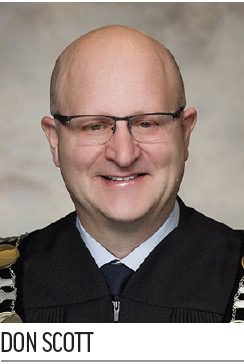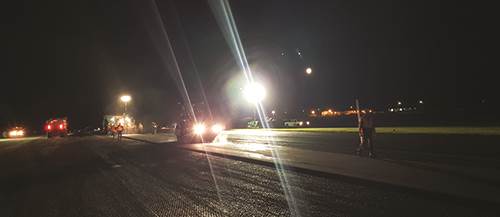At a time when some airports were pressing the proverbial pause button on all construction and improvements, Fort McMurray International (YMM) in Alberta was moving ahead with plans for a major runway rehabilitation. The $15 million project was completed in May, funded entirely by the regional municipality of Wood Buffalo.
At a time when some airports were pressing the proverbial pause button on all construction and improvements, Fort McMurray International (YMM) in Alberta was moving ahead with plans for a major runway rehabilitation. The $15 million project was completed in May, funded entirely by the regional municipality of Wood Buffalo.
 R.J. Steenstra, president and chief executive officer of Fort McMurray Airport Authority, notes that keeping Runway 8-26 in good condition was a critical need not only for YMM, but also for the surrounding areas that depend on the airport as a key launch pad for food, medicine and people.
R.J. Steenstra, president and chief executive officer of Fort McMurray Airport Authority, notes that keeping Runway 8-26 in good condition was a critical need not only for YMM, but also for the surrounding areas that depend on the airport as a key launch pad for food, medicine and people.
“We knew that the runway was due for an overlay, and we needed to find a way to support this strategic investment,” says Steenstra, adding that it had been 19 years since the airport’s sole runway had been resurfaced.
|
Project: Runway Rehabilitation Location: Fort McMurray (AB) Int’l Airport Scope: Fresh overlay for 7,503 x 150-foot runway; LED airfield lighting & signage; runway end safety areas Cost: $15 million Fully Funded by: Community Investment Program of Buffalo Wood regional municipality Initial Planning: 2017 Funding Secured: 2019 Contracts Awarded: Spring 2020 Construction: June 2020-May 2021
General Contractor: Milling: A. LeDuc Developments
Lighting Contractor: Airfield Markings: Marshall Lines Key Benefits: Enhanced safety & operational efficiency; reduced energy costs from new LED lighting |
When YMM began the planning process in 2017, it reached out to one of its strongest partners, the regional municipality of Wood Buffalo. “The airport is not a division of the city, which is why approaching the municipality for funding was so unique,” Steenstra explains. “We believe Fort McMurray Airport and the runway are very strategic assets in the community.”
The municipality apparently agreed, because it approved YMM’s request in 2019, fully funding the project through its Community Investment Program. Specifically, the runway improvements fit the program’s strategic initiatives to support emergency response and safety, economic development and outreach to Indigenous and rural communities.

“This was the right capital investment at the right time,” says Wood Buffalo Mayor Don Scott. “The airport is a critically important asset for our community, and the new runway will ensure that it continues to support economic development and recovery by facilitating growth opportunities and welcoming more individuals and families to our region.”
In particular, many communities in Northern Canada depend on YMM to transport vital goods and oil industry workers. Steenstra notes that the airport is an important access point, even during the current pandemic.
Making the Case
To secure funding from the regional municipality, YMM developed a compelling submission and provided detailed plans about the airfield project. It also highlighted how the proposed construction would support the needs of Fort McMurray and surrounding areas. Following the written submission, the airport team presented its plan in person to the municipality for approval. But before doing so, executives found an ally in Fort McMurray Economic Development to support their funding request.
Despite strong demand for Community Investment Program grants, YMM secured full funding for its $15 million project. In addition to rehabilitating the asphalt pavement on its 7,503-foot-long, 150-foot-wide runway, YMM was able to improve airfield lighting/signage and add a runway end safety area at each end.
“Through this support, we have a runway infrastructure that can support us for at least the next 15 years,” says Cuyler Green, vice president of Airport Operations at YMM.

New LED lighting and guidance signs were a direct response to requests from passenger and cargo airlines.
During winter, limited visibility can create difficult conditions for pilots landing on snow-covered runways and taxiing around snow berms; so the upgraded lighting and signage helps a lot, explains Green.
In addition to enhancing operational safety, the new lighting is reducing energy costs. Green notes that electricity can be expensive in northern Alberta, but LED technology helps decrease the airport’s electricity bill.
The project also satisfies new requirements from Transport Canada Civil Aviation regarding runway end safety areas. YMM added 150 meters at each end of its runway to help aircraft stop safely in case of an emergency. Leveraging LED technology for new and existing approach lighting systems enhances landing safety.
Proceed with Construction
While flight volume around the world began to take a steep downturn, YMM initiated a competitive tender process for its runway project. By April 2020, it had selected a general contractor.
“The challenging decision was whether to move forward with the rehabilitation project or not given the global pandemic,” Green recalls. “There was a lot of uncertainty in the industry about contractors receiving materials on time.”
The airport considered delaying the project because of changing COVID-19 safety protocols and supply chain disruptions, but ultimately decided to move forward.
As the project team reviewed proposals from contractors, it prioritized factors such as overall experience and the ability to meet the proposed construction schedule despite the complexities of working in an airfield environment.
There was also a prevailing desire to create jobs within the local community, which was ravaged by wildfires in 2016 and experienced historic flooding in 2020. Fortunately, YMM received significant interest from local companies wanting to compete for the significant hometown project.
“We were able to award the project to a local company that created local jobs and made a local economic impact,” Steenstra reports.
E-Construction began work as the project’s general contractor in June 2020 with at least 50 area residents on its payroll.
 “We were very happy to be selected as the contractor to complete this project,” says Michael Wheating, North Division manager for E-Construction. “We feel that we were able to draw from our company’s wealth of expertise and experience in airport construction throughout Alberta to provide the best value and product possible.”
“We were very happy to be selected as the contractor to complete this project,” says Michael Wheating, North Division manager for E-Construction. “We feel that we were able to draw from our company’s wealth of expertise and experience in airport construction throughout Alberta to provide the best value and product possible.”
As planning progressed, the airport discovered silver linings associated with completing the airfield work while a global pandemic was decreasing traffic for YMM and the rest of the industry.
“The pandemic offered us a window that we would not have normally had,” explains Steenstra. “We had reduced schedules, which allowed us to be more efficient in getting this project completed and have as little impact as possible on the community and air carriers.”
Eight-hour runway closures were put in place to keep construction on schedule.
“This major project was designed to not only enhance the runway, but also maintain our focus on safety,” notes Green. “For that to happen, we needed to perform the work overnight and closely coordinate with the airlines.”
E-Construction and the airport worked together to develop detailed plans and foster collaboration between construction crews and the two main scheduled air carriers operating at YMM.

Choosing an experienced contractor and stressing the importance of planning and coordination paid off, because the project finished on time in May 2021.
“More than 80 tenants depend on the airport for their livelihood, making this runway project incredibly important to the region,” Steenstra emphasizes. “It’s important to have a runway equipped with the lighting and technology that can support the airport, air carriers, our partners and our community’s needs.”
The runway rehabilitation project positively impacted air travel, cargo, oil, tourism and retail for Fort McMurray and the area’s northernmost towns. It also allowed the airport to keep capital investments connected to the local economy and improve the quality of life for residents throughout the region.


 facts&figures
facts&figures

